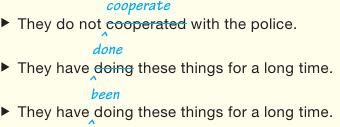T2-c Use the correct verb forms after helping verbs.
base form The uninflected form of a verb: I eat; to play.
After the helping (auxiliary) verbs do, does, and did, always use the base form of the main verb. After the helping verbs have, has, and had, always use the past participle form of the main verb. (See R2-a and G5.)

modals The helping verbs can, could, may, might, must, shall, should, will, and would, which must be used in conjunction with another (main) verb: I may go to the bank.
A modal such as will sometimes precedes have, has, or had.
- By Friday I will have finished this project.
Following the helping verbs be, am, is, are, was, were, and been (forms of be), use the present participle to show ongoing action (progressive tense).

Use one of the modal verbs with be. Use have, has, or had with been.
- Terence could be making some calls while I am out.
- I have been working hard.
passive voice The verb form that shows something happening to the subject.
After the helping verbs am, is, are, was, and were (forms of be), use the past participle to form the passive voice.

To form the passive, be, being, and been need another helping verb in addition to the past participle.
- Tonya will be challenged in graduate school this fall.
After a modal, use the base form.
- The Senate might vote on this bill next week.